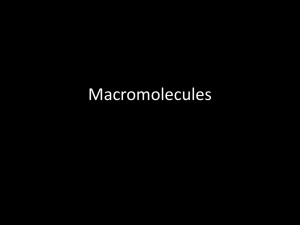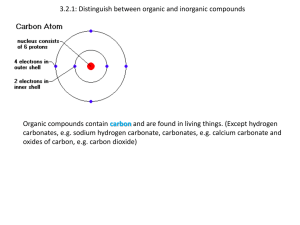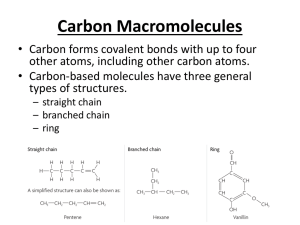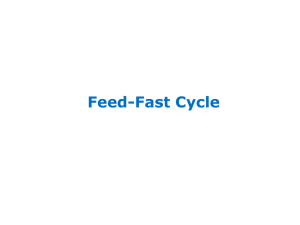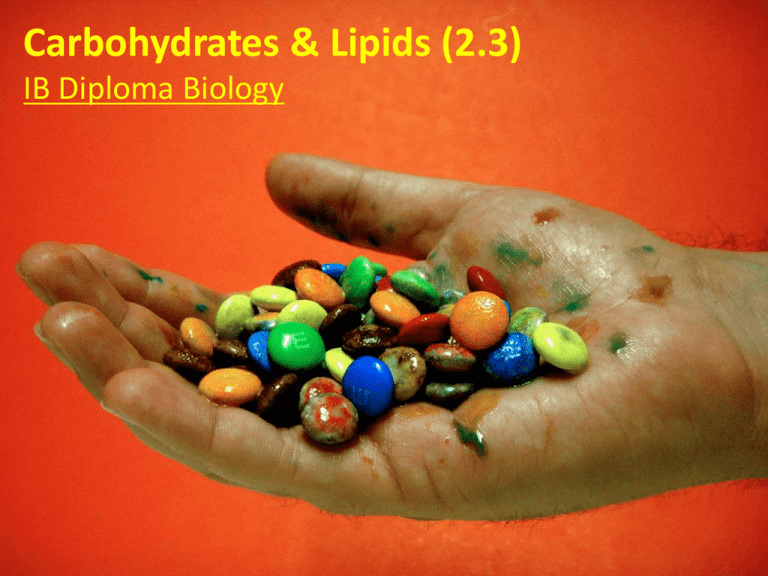
Carbohydrates & Lipids (2.3)
IB Diploma Biology
Essential Idea: Compounds of carbon, hydrogen and
oxygen are used to supply and store energy.
When you are building and drawing molecules it is essential to remember that it's the
bonds between the atoms where energy is stored. Organic molecules are often complex
and hence contain many bonds. The background image is a molecular model that shows
a small part of a cellulose molecule.
2.3.1 Monosaccharide monomers are linked together by condensation
reactions to form disaccharides and polysaccharide polymers.
Monosaccharide #1 Glucose has the formula C H
6 12O6
It forms a hexagonal ring (hexose)
Glucose is the form
of sugar that fuels
respiration
Glucose forms the
base unit for many
polymers
5 of the carbons form
corners on the ring
with the 6th corner
taken by oxygen
2.3.1 Monosaccharide monomers are linked together by condensation
reactions to form disaccharides and polysaccharide polymers.
Monosaccharide #2
Galactose is also
a hexose sugar
It has the same
formula C6H12O6 but
is less sweet
Most commonly
found in milk,
but also found
in cereals
2.3.1 Monosaccharide monomers are linked together by condensation
reactions to form disaccharides and polysaccharide polymers.
Monosaccharide #3
Fructose is another
pentose sugar
Commonly found in
fruits and honey
It is the sweetest
naturally occurring
carbohydrate
2.3.1 Monosaccharide monomers are linked together by condensation
reactions to form disaccharides and polysaccharide polymers.
Monosaccharide #4
Ribose is a pentose
sugar, it has a
pentagonal ring
It forms the backbone
of RNA
Deoxyribose differs
as shown in the
diagram, and forms the
backbone of DNA
2.3.1 Monosaccharide monomers are linked together by condensation
reactions to form disaccharides and polysaccharide polymers.
2.3.1 Monosaccharide monomers are linked together by condensation
reactions to form disaccharides and polysaccharide polymers.
2.3.1 Monosaccharide monomers are linked together by condensation
reactions to form disaccharides and polysaccharide polymers.
Disaccharide #1
Maltose (C12H22O11) is a
dimer of glucose
Gosh! Isn’t it sweet?! The two glucose
molecules are holding hands.
2.3.1 Monosaccharide monomers are linked together by condensation
reactions to form disaccharides and polysaccharide polymers.
Disaccharide #2
Lactose (C12H22O11) is most
(Literally “two sugars”)
commonly found in milk
The two subunits that
make up lactose are
glucose and galactose,
our friends from a
couple of slides ago.
2.3.1 Monosaccharide monomers are linked together by condensation
reactions to form disaccharides and polysaccharide polymers.
Disaccharide #3
Sucrose (C12H22O11) is also
known as table sugar
The two subunits that
The two monosaccharides
make up sucrose are
that make it up are
glucose and fructose.
glucose and fructose
2.3.1 Monosaccharide monomers are linked together by condensation
reactions to form disaccharides and polysaccharide polymers.
2.3.9 Use of molecular visualization software to compare cellulose,
starch and glycogen.
The easiest way to use Jmol is to use the ready-made models from
on the biotopics website
• Click on the models or the logo below to access them
• Play with the models, move them, zoom in and out
2.3.5 Structure and function of cellulose and starch in plants and
glycogen in humans.
Polysaccharide #1
CELLULOSE
•
•
•
•
•
•
•
•
•
Cellulose is made by linking together glucose.
Condensation reactions link carbon atom 1 to
carbon atom 4 on the next β-glucose.
The glucose subunits in the chain are oriented
alternately upwards and downwards.
The consequence of this is that the cellulose
molecule is a straight chain, rather than curved.
Cellulose molecules are unbranched chains of glucose.
Hydrogen bonds link the the molecules together.
The linked molecules form bundles called cellulose microfibrils.
They have very high tensile strength.
The tensile strength of cellulose (the basis of cell walls) prevents
plant cells from bursting, even under very high (water) pressure.
2.3.5 Structure and function of cellulose and starch in plants and
glycogen in humans.
Polysaccharide #2
STARCH
•
•
•
•
•
Amylose and
Amylopectin are both
forms of starch and
made from repeating
glucose units
Starch is made by linking together α-glucose molecules
Condensation reactions link carbon atom 1 to carbon atom 4 on the next α-glucose
All the glucose molecules in starch can be orientated in the same way
The consequence of this is that the starch molecule is curved, rather than straight.
Size of the molecule is not fixed
2.3.A1 Structure and function of cellulose and starch in plants and
glycogen in humans.
Polysaccharide #2
• In Amylopectin the chain is branched,
so has a more globular shape.
• Due it’s branched nature amylopectin
can be much larger consisting of 2,000200,000 units
•
•
•
•
•
•
Starch is only made by plant cells.
Molecules of both types of starch are
hydrophilic but are too large to be soluble
Starch does not affect the osmotic balance
of cells, i.e. cause too much water to enter
It is easy to add or remove extra glucose
molecules to starch; good energy store
In seeds and storage organs such as potato
cells glucose held as starch.
Starch is made as a temporary store in leaf
cells when glucose is being made faster by
photosynthesis than it can be exported to
other parts of the plant.
• In Amylose the chain of α-glucose molecules
is un-branched and forms a helix.
• Typically amylose is made up of 300-3,000
glucose units
2.3.5 Structure and function of cellulose and starch in plants and
glycogen in humans.
Polysaccharide #3:
GLYCOGEN
•
Glycogen (C6H10O5)n is a polymer made
from repeating glucose subunits
•
The molecule varies in size, typically it
consists of 30,000 units
• Glycogen is not just a simple chain,
it branches many times
• As a result the molecule is compact
•
•
•
Glycogen does not affect the osmotic balance of cells, i.e. cause too
much water to enter them
•
It is easy to add or remove extra glucose molecules to starch
•
Therefore glycogen is useful in cells for glucose, and consequently
energy, storage.
•
Glycogen is made by
animals and some fungi
It is stored in the liver
and some muscles in
humans.
It is used in cells where
large stores of dissolved
glucose would cause
osmotic problems.
2.3.4 Triglycerides are formed by condensation from three fatty
acids and one glycerol.
Condensation reaction between glycerol and fatty acids
2.3.4 Triglycerides are formed by condensation from three fatty
acids and one glycerol.
Condensation reaction between glycerol and fatty acids
Glycerol
Three Fatty Acids
Triglyceride
Lipids are glycerol combined with 1, 2 or 3 fatty
acids, therefore triglycerides are lipids
n.b. hydrolysis is the reverse of this process, catalysed
by lipase
3H2O
Covalent bonds called ester bonds are
formed between the fatty acids and
glycerol molecules.
2.3.7 Lipids are more suitable for long-term energy storage in
humans than carbohydrates.
Functions of lipids:
•
Structure: Phospholipids are a main
component of cell membranes
•
Hormonal signaling: Steroids are
involved in hormonal signaling (e.g.
estrogen, progesterone, testosterone)
•
Insulation: Fats in animals can serve as
heat insulators while sphingolipids in the
myelin sheath (of neurons) can serve as
electrical insulators
•
Protection: Triglycerides may form a
tissue layer around many key internal
organs and provide protection against
physical injury
•
Storage of energy: Triglycerides can be
used as a long-term energy storage
source
• Lipids are normally used for long-term
energy storage whereas carbohydrates are
used for short-term energy storage
• The lipids that are used are fats. They are
stored in specialized groups of cells called
adipose tissue. Adipose tissue is located
immediately beneath the skin and also
around some organs including the kidneys.
2.3.7 Lipids are more suitable for long-term energy storage in
humans than carbohydrates.
Reasons for using lipids for long-term
energy storage…
• The amount of energy released in cell
respiration per gram of lipids is more than
double that for carbohydrates (and
protein): 9 Cal/g v. 4 Cal/g
• Lipids add 1/6 as much to body mass as
carbohydrates: fats are stored as pure
droplets whereas when 1g glycogen is
stored it is associated with 2g of water.
This is especially critical for active animals
as energy stores have to be carried.
2.3.7 Lipids are more suitable for long-term energy storage in
humans than carbohydrates.
Why is glycogen is needed at all?
• This is because glycogen can be broken down to
glucose rapidly and then transported easily by the
blood to where it is needed
• Fats in adipose tissue cannot be mobilized as rapidly
• Glucose can be used either in anaerobic or aerobic
cell respiration whereas fats and fatty acids can only
be used in aerobic respiration
2.3.7 Lipids are more suitable for long-term energy storage in
humans than carbohydrates.
Glycogen is the medium-term energy storage molecule in animals. It is stored in the
liver and muscles. The energy stored in glycogen is more readily available than the
energy stored in fat.
Glucose in the bloodstream is for immediate use and will either be used in
respiration to yield ATP or converted to glycogen or fat
Wallet
(Glycogen)
An analogy:
easy to get to,
would be too big if you put
in all your money
You are
paid in cash
(Glucose)
Bank
(Fat)
Spend it!
(Respiration)
Can put lots of money here, more
of a hassle to get it back out
Carbohydrates vs. Lipids for energy storage
2.3.10 Determination of body mass index by calculation or use of a
nomogram.
In some parts of the world food supplies are
insufficient or are unevenly distributed and many
people as a result are underweight.
Obesity is an increasing problem in some countries.
Obesity increases the risk of conditions such as
coronary heart disease and type II diabetes. It
reduces life expectancy significantly and is increasing
the overall costs of health care in countries where
rates of obesity are rising.
Body Mass Index (BMI) is used as a
screening tool to identify possible weight
problems, however, BMI is not a diagnostic
tool. To determine if excess weight is a
health risk further assessments are needed
such as:
• skinfold thickness measurements
• evaluations of diet
• physical activity
• and family history
The table below can be used to assess an
adult’s status…
BMI
Status
Below 18.5
Underweight
18.5 – 24.9
Normal
25.0 – 29.9
Overweight
30.0 and Above
Obese
2.3.10 Determination of body mass index by calculation or use of a
nomogram.
BMI is calculated the same way for both
adults and children. The calculation is
based on the following formula:
BMI =
mass in kilograms
(height in meters)2
n.b. units for BMI are kg m-2
Example:
Mass = 68 kg, Height = 165 cm (1.65 m)
BMI = 68 ÷ (1.65)2 = 24.98 kg m-2
In this example the adult would be
(borderline) overweight - see the table on
the previous slide
Charts such as the one to the right can
also be used to assess BMI.
2.3.10 Determination of body mass index by calculation or use of a
nomogram.
An alternative to calculating the
BMI is a nomogram. Simply use a
ruler to draw a line from the
body mass (weight) to the height
of a person. Where it intersects
the W/H2 line the person’s BMI
can be determined. Now use the
table to assess their BMI status.
BMI
Status
Below 18.5
Underweight
18.5 – 24.9
Normal
25.0 – 29.9
Overweight
30.0 and
Above
Obese
2.3.10 Determination of body mass index by calculation or use of a
nomogram.
1. A man has a mass of 75 kg and a
height of 1.45 metres.
a. Calculate his body mass index.
(1)
b. Deduce the body mass status of
this man using the table. (1)
BMI = mass in kilograms ÷ (height in metres)2
= 75 kg ÷ (1.45 m)2
= 75 kg ÷ 2.10 m2
= 35.7 kg m-2
35.7 kg m-2 is above 30.0 (see table below)
therefore the person would be classified obese.
BMI
Status
c. Outline the relationship
between height and BMI for a
fixed body mass. (1)
Below 18.5
Underweight
18.5 – 24.9
Normal
The taller a person the smaller the
BMI;
25.0 – 29.9
Overweight
30.0 and Above
Obese
(negative correlation, but not a
linear relationship)
2.3.10 Determination of body mass index by calculation or use of a
nomogram.
4. A woman has a height of 150 cm and BMI = mass in kilograms ÷ (height in metres)2
a BMI of 40.
a. Calculate the minimum amount
therefore
of body mass she must lose to
2
reach normal body mass status. mass in kilograms = BMI ÷ (height in metres)
Show all of your working. (3)
b. Suggest two ways in which the
woman could reduce her body
mass. (2)
Reduce her nutritional intake /
diet / reduce the intake of lipids;
Exercise / increase activity levels;
Actual body mass = BMI ÷ (height in metres)2
= 40 kg m-2 x (1.50 m)2
= 90 kg
Normal BMI is a maximum of 24.9 kg m-2
Normal body mass = 24.9 kg m-2 x (1.5 m)2
= 56 kg
To reach normal status the woman needs to lose
90 kg – 56 kg = 34 kg
Flash Back: 2.1.9 Identification of biochemicals such as sugars,
lipids or amino acids from molecular diagrams.
General structural formula for a fatty* acid
H3C
(CH2)n
Chain (or ring) of carbon
and hydrogen atoms
*I prefer “big boned”
O
C
OH
Carboxylic group
2.3.2 Fatty acids can be saturated, monounsaturated or
polyunsaturated.
Saturated, monounsaturated or polyunsaturated?
Q1 Oleic Acid
Q2 Caproic Acid
Q3 α-Linolenic Acid
2.3.2 Fatty acids can be saturated, monounsaturated or
polyunsaturated.
Saturated, monounsaturated or polyunsaturated?
Q1 Oleic Acid
1 double bond therefore monounsaturated
Q2 Caproic Acid no double bonds therefore unsaturated
Q3 α-Linolenic Acid
3 double bonds therefore polyunsaturated
n.b. the term saturated refers to
whether more hydrogen can be
added to the fatty acid. A double
bond can be replaced if two
hydrogen atoms are added. If there
are no double bonds a fatty acid is
said to be saturated as no more
hydrogen atoms can be added.
https://commons.wikimedia.org/wiki/Fatty_acids#Polyunsaturated_fatty_acids_2
2.3.3 Unsaturated fatty acids can be cis or trans isomers.
Cis - isomers
Trans - isomers
Very common in nature
Rare in nature – usually artificially produced to
produce solid fats, e.g. margarine from vegetable oils.
the hydrogen atoms are on the same side of the two
carbon atoms
the hydrogen atoms are on the same side of the two
carbon atoms
The double bond causes a bend in the fatty acid chain
The double bond does not causes a bend in the fatty
acid chain
Therefore cis-isomers are only loosely packed
Trans-isomers can be closely packed
Triglycerides formed from cis-isomers have low melting
points – they usually liquid at room temperature
Triglycerides formed from trans-isomers have high
melting points – they usually solid at room temp.
2.3.3 Unsaturated fatty acids can be cis or trans isomers.
Q1 trans or cis isomers?
???
???
2.3.3 Unsaturated fatty acids can be cis or trans isomers.
Q1 trans or cis isomers?
2.3.3 Unsaturated fatty acids can be cis or trans isomers.
Q2 trans or cis isomer of α-Linolenic Acid?
2.3.3 Unsaturated fatty acids can be cis or trans isomers.
Q2 trans or cis isomer of α-Linolenic Acid?
All 3 double bonds are cis, each one causes a bend in
the fatty acid chain.
2.3.6 Scientific evidence for health risks of trans fats and saturated
fatty acids.
There have been many claims about the effects of different types of fat on human
health. The main concern is coronary heart disease (CHD). In this disease the
coronary arteries become partially blocked by fatty deposits, leading to blood clot
formation and heart attacks.
2.3.6 Scientific evidence for health risks of trans fats and saturated
fatty acids.
• A positive correlation has been found between saturated fatty acid intake and
rates of CHD in many studies.
• Correlation ≠ causation. Another factor, e.g. dietary fiber could be responsible.
• There are populations that do not fit the correlation such as the Masai of Kenya.
They have a diet that is rich in meat, fat, blood and milk. They therefore have a high
consumption of saturated fats, yet CHD is almost unknown among Masai.
• Diets rich in olive oil, which contains cis-monounsaturated fatty acids, are
traditionally eaten in countries around the Mediterranean. The populations of these
countries typically have low rates of CHD and it has been claimed that this is due to
the intake of cis-monounsaturated fatty acids.
• Genetic factors in these populations could be responsible.
• There is also a positive correlation between amounts of trans-fat consumed
and rates of CHD.
• Other risk factors have been tested, to see if they can account for the
correlation, but none did. Trans-fats therefore probably do cause CHD.
• In patients who had died from CHD, fatty deposits in the diseased arteries have
been found to contain high concentrations of trans-fats, which gives more
evidence of a causal link.
2.3.8 Evaluation of evidence and the methods used to obtain the
evidence for health claims made about lipids.
Which health claims
are valid?
http://www.foxnews.com/health/2013/02/18/raspberry-ketone-be-wary-this-diet-trend/
http://www.forbes.com/2004/04/21/cz_af_0421feat.html
http://www.badscience.net/2009/08/health-warning-exercise-makes-you-fat/
2.3.8 Evaluation of evidence and the methods used to obtain the
evidence for health claims made about lipids.
Evidence for health claims comes from research. Some of this research is
more scientifically valid than others.
Evaluation = Make an appraisal by weighing
up the strengths and limitations
Key questions to consider for the
strengths are:
•
•
Is there a correlation between intake
of the lipid being investigated and rate
of the disease or the health benefit?
Key questions to consider for the limitations are:
If mean values are being compared
how different are they? Has this
difference been assessed statistically?
•
•
•
•
•
How widely spread is the data? This
can be assessed by the spread of data
points or the relative size of error
bars. The more widely spread the data
the smaller the significance can be
placed on the correlation and/or the
conclusion.
•
•
•
Was the measure of the health a valid one? Cholesterol
levels in blood are more informative than BMI
How large was the sample size?
Does the sample reflect population as a whole or just a
particular sex, age, state of health, lifestyle or ethnicity?
Was the data gathered from human or animal trials? If
only done of animals how applicable are the findings?
Were all the important control variables, e.g. level of
activity, effectively controlled?
Were the levels and frequency of the lipids (or substance
studied) intake realistic?
How rigorous were methods used to gather data? e.g. If
only a survey was used how truthful were respondents?


